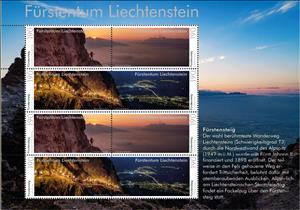Full Pane: Panoramas of Liechtenstein : The Prince's Climb (Liechtenstein 2025)
Panoramas of Liechtenstein : The Prince's Climb (Liechtenstein 2025)
02 June (Liechtenstein ) within release Panoramas of Liechtenstein : The Prince's Climb (2025) goes into circulation Full Pane Panoramas of Liechtenstein : The Prince's Climb face value 8*190 Swiss centime
| Full Pane Panoramas of Liechtenstein : The Prince's Climb in catalogues | |
|---|---|
| Colnect codes: | Col: LI 2025.06.02-01e |
Full Pane is horizontal format.
Isused in panes containing two se-tenant blocks of four.Also in the issue Panoramas of Liechtenstein : The Prince's Climb (2025):
- Se-tenant - Panoramas of Liechtenstein : The Prince's Climb face value 4*190;
- Full Pane - Panoramas of Liechtenstein : The Prince's Climb face value 8*190;
- Stamp - Panoramas of Liechtenstein : The Prince's Climb face value 190;
- Stamp - Panoramas of Liechtenstein : The Prince's Climb face value 190;
- Stamp - Panoramas of Liechtenstein : The Prince's Climb face value 190;
- Stamp - Panoramas of Liechtenstein : The Prince's Climb face value 190;
Full Pane Panoramas of Liechtenstein : The Prince's Climb it reflects the thematic directions:
A hike is a long, vigorous walk, usually on trails or footpaths in the countryside. Walking for pleasure developed in Europe during the eighteenth century. Long hikes as part of a religious pilgrimage have existed for a much longer time. "Hiking" is the preferred term in Canada and the United States; the term "walking" is used in these regions for shorter, particularly urban walks. In the United Kingdom and Ireland, the word "walking" describes all forms of walking, whether it is a walk in the park or backpacking in the Alps. The word hiking is also often used in the UK, along with rambling, hillwalking, and fell walking (a term mostly used for hillwalking in northern England). The term bushwalking is endemic to Australia, having been adopted by the Sydney Bush Walkers Club in 1927. In New Zealand a long, vigorous walk or hike is called tramping. It is a popular activity with numerous hiking organizations worldwide, and studies suggest that all forms of walking have health benefits
A landscape is the visible features of an area of land, its landforms and how they integrate with natural or man-made features. A landscape includes the physical elements of geophysically defined landforms such as (ice-capped) mountains, hills, water bodies such as rivers, lakes, ponds and the sea, living elements of land cover including indigenous vegetation, human elements including different forms of land use, buildings and structures, and transitory elements such as lighting and weather conditions. Combining both their physical origins and the cultural overlay of human presence, often created over millennia, landscapes reflect a living synthesis of people and place that is vital to local and national identity. The character of a landscape helps define the self-image of the people who inhabit it and a sense of place that differentiates one region from other regions. It is the dynamic backdrop to people’s lives. Landscape can be as varied as farmland, a landscape park, or wilderness. The earth has a vast range of landscapes, including the icy landscapes of polar regions, mountainous landscapes, vast arid desert landscapes, islands and coastal landscapes, densely forested or wooded landscapes including past boreal forests and tropical rainforests, and agricultural landscapes of temperate and tropical regions.


